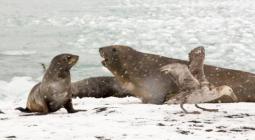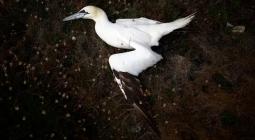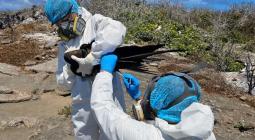Bird flu confirmed among mass sub-Antarctic seal deaths as virus continues global spread
Scientists warn further spread could threaten fragile ecosystem, as tests show seals died of H5N1 on South Georgia island
A virology team has confirmed the first bird flu infections in elephant and fur seals in the sub-Antarctic region, as the highly contagious H5N1 virus continues to spread around the world.
Researchers previously reported the mass deaths of seals and that a number of elephant seals on South Georgia island – a UK overseas territory in the southern Atlantic Ocean – had been exhibiting symptoms of avian flu. But while seabird cases were confirmed, the seal infections were classed as suspected, pending lab results.
The first known cases of H5N1 were detected in the Antarctic region in October among brown skua on Bird Island, off South Georgia. Two months later, hundreds of elephant seals were found dead. There have also been increased deaths of fur seals, kelp gulls and brown skua at several other sites.
Marco Falchieri, a scientist in the UK Animal and Plant Health Agency’s (APHA) influenza and avian virology team, which collected the South Georgia samples that tested positive for bird flu. He said he saw about 20 dead elephant seals. “Emotionally it is almost heartbreaking to see so many dead seals.”
Other seals were showing respiratory signs of bird flu, he said, citing “coughs, sneezing, ocular discharge, nasal discharge, slow head shaking and tremors”.
Falchieri said the death toll on South Georgia was probably about 100, mainly elephant seals, who appear to be more affected than fur seals.
“My worst fear is an adaptive mutation to mammals, which we are not seeing in these new samples, but we need to keep monitoring,” he said. An adaptive mutation, he added, “could mean it becomes a mammalian-adapted virus, and consequently increases risk for humans too”.
The spillover to the South Georgia mammals is “a reflection of what’s going on globally”, said Ashley Banyard, an APHA virologist. Banyard’s team diagnosed the samples brought back from the island in mid-December.
Spillovers occurred, Banyard said, “when too many birds have bird flu [and] mammals come into close contact with sick birds’ poo or when the mammals eat [an] infected bird carcass”.
In December, the death of a polar bear from bird flu in Alaska was confirmed, and an estimated 20,000 sea lions have died from the virus in Chile and Peru.
Although the sub-Antarctic seal and bird deaths are a concern, Banyard said it was good news that the virus had not spread to other species. “Two years ago, we were worried about the penguins being infected and dying from the disease in the region, but that has not happened, so this is almost a positive outcome.”
If bird flu continued to spread throughout the sub-Antarctic region, however, he said it “could significantly threaten the fragile ecosystem, and potentially put a number of very large populations of seabirds and sea mammals at risk”.
Norman Ratcliffe, a seabird ecologist with the British Antarctic Survey, said about 98% of the global population of fur seals were found in South Georgia, and that the region hosted “globally important populations of elephant and fur seals [and these] populations are now at risk from large declines”.
Ratcliffe said there was no way to know total seal deaths, either due to deaths at sea or carcasses being scavenged, “but we know the number of dead is far higher than what we see – and the mortality is much higher than normal rates for this time of year”.
Cover photo: A southern elephant seal on South Georgia island. Photograph: Zoonar GmbH/Alamy





